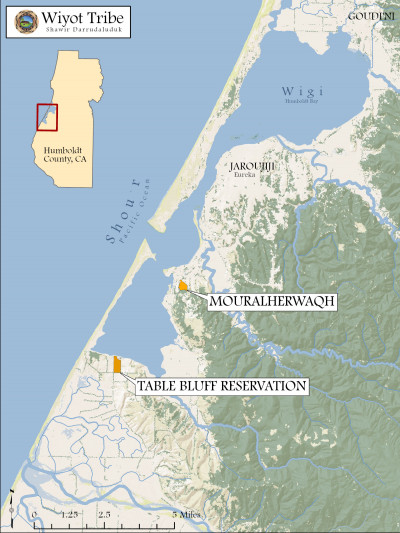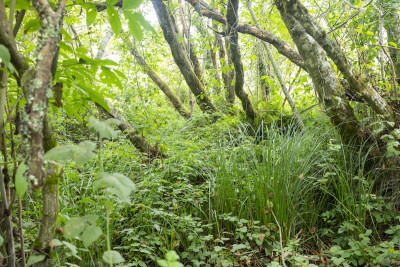Every day that Daniel “Bubba” Lipe leads students into the forests at Mouralherwaqh begins the same way. “We spend the first 15 minutes of the day connecting to the place,” says Lipe, an assistant professor in Environmental Science Management at California State Polytechnic University, Humboldt.
The visits are part of a summer program that Lipe co-leads with Zack Erickson, the forest resources specialist for the Wiyot Tribe. They call these 15 minutes a “protocol” — though, importantly, Lipe and Erickson do not dictate how the connection occurs. Instead, they offer models: Lipe, for example, steps away to listen quietly, to observe and ensure that he’s welcome in this space. “This is my way, from where I’m from,” Lipe says.

Mouralherwaqh — pronounced more-AW-shore-a-wah — is a 46-acre parcel along what is marked on most maps as Humboldt Bay and is known to the Wiyot people as Wigi. Most of the land along the bay is developed; here at Mouralherwaqh, though, the ecosystems remain intact. There’s a rare stand of sedge and cattail wetlands and, slightly inland, mature Sitka spruce forests stand uncut. For the past two summers, undergraduate students have helped the Wiyot Tribe collect data on these trees. But the opening protocol, Lipe says, helps students realize that “the animals and plants are not something we learn about — but something we learn from and learn with.”
This is a foundational concept in Traditional Ecological Knowledge, or TEK, a diverse set of practices and insights that have been passed down through generations of Indigenous people. Lipe, a member of the Cherokee Nation, came to Cal Poly Humboldt in 2022, to help the school fold TEK into the curriculum across disciplines. He notes that Western science is often hyperfocused on one question at a time; TEK emphasizes interconnections and reciprocity, in which beings human and nonhuman have responsibilities and obligations to one another.
There’s a gap between the methods, Lipe admits. “But my work is focused on how we reduce that gap,” he says. “Where do we find places where there’s overlap?”
Erickson and Lipe have been leading the program for two summers, introducing undergraduate students to holistic, Indigenous-led restoration processes. Thirteen students from three institutions — Cal Poly Humboldt, College of the Redwoods, and the University of California, Davis — have participated. Most of the students are indigenous themselves and two are citizens of the Wiyot Tribe.

Seeds for the program were planted when the Wiyot Tribe received a grant from the California Ocean Protection Council to purchase Mouralherwaqh in 2022. Adam Canter, director of the Wiyot Tribe’s Natural Resource Department, led the grant application process, and California Sea Grant extension specialist and Cal Poly Humboldt faculty member Laurie Richmond assisted with logistics. The acquisition increased the tribe’s land holdings by 10%, though even now they own less than 1% of their ancestral land.
The grant included funding for the Tribe to develop a long-term restoration and management plan for the land. And to do that, “we needed to figure out what's there and who's there — in what abundance and in what quality,” Erickson says. Rather than hiring consultants to collect this baseline data, Erickson realized he could partner with Cal Poly Humboldt to provide something bigger.
Erickson, also a citizen of the Cherokee Nation, was trained in Western forestry practices and felt comfortable training students to use the forestry tools needed to collect baseline data for grant reports. “But I also brought a want — and a need — to be able to view the forest as more than just a resource. More than just measuring board feet and seeing how much wood we can take out,” he says.
Working with Lipe, Erickson developed a program in which students conduct forestry, wetland and water quality assessments, learn from Wiyot Tribe cultural practitioners and attend a cultural burning symposium. Even while using traditional forestry tools, students see that they can consider bigger questions than board feet. For example, amid instruction or measurements, if a bird flew past, Lipe would stop to listen — and ask students to consider who the bird was and what it might be saying.
“That’s how I was raised,” Lipe says. “When jaybird talks, you listen.”
Richmond led activities that taught students about coastal resilience and sea-level rise beyond Mouralherwaqh, across Wigi. Cal Poly Humboldt Engineering faculty member and citizen of the Cherokee Nation Qualla Ketchum also supported program activities and instruction. During the last week of the program, the students leave Mouralherwaqh and camp in forests within the ancestral lands of the Karuk Tribe. There, they work with Frank Lake, who as a U.S. Forest Service research ecologist and a Karuk descendant and cultural practitioner is ensuring federal lands are managed in culturally responsive ways. This week underlines the fact that traditional knowledge is place-based. A single tool may be used differently, given different local contexts, Lipe notes: in Mouralherwaqh, fire can sustain wetlands and open grasslands; in Karuk lands, along salmon-producing streams, it makes sense to use fire to increase streamflow and, by creating smoke cover, reducing temperatures.
For most of the students who participated, the program was their first experience of fieldwork — making it all the more powerful the program’s demonstration that Western science and TEK are not in opposition but are complementary. “These are two ways of looking at the world,” Erickson notes, “and now students are in a position to translate.”
Lipe, though, suggests one word change: “For me personally, it’s more how we transit between these two worlds,” he says. “Not everything can be translated, but students can now transit between these two worldviews.